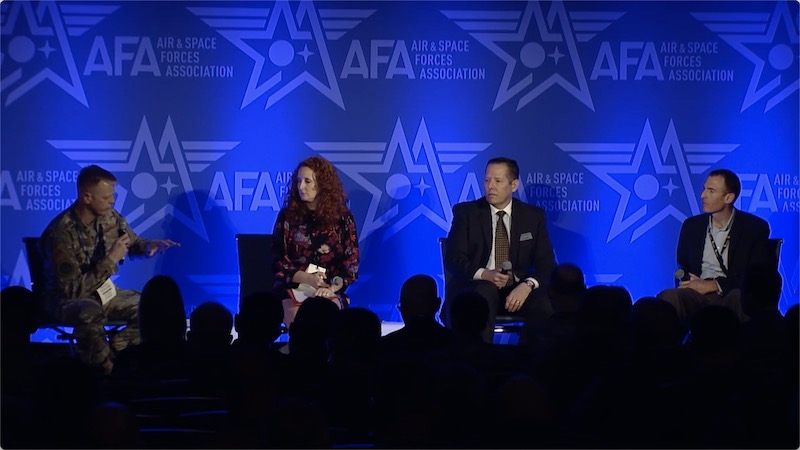作为数字孪生战场实验室编写的《数字空军白皮书》(Digital Air Force Whitepaper)的补充,从美国空军及其供应商专家对ABMS的讨论了解真相,是一种有效的方法。
众所周知,ABMS是JADC2在美国空军的具体应用,它体现了美国空军的军事需求,对武器装备的指引作用非常明显,成为任何行业人士了解美国空军发展的风向标。
美国空军C3BM项目办公室主任卢克·克罗普西是决定ABMS发展和项目管理的重要人物,他在美国空天协会举办的讨论会上,作为活动的主持人,他跟来自洛克希德·马丁的丹·马克姆、L3Harris的罗恩·费伦和雷神技术公司的伊莱恩·比通蒂做了对话。
本篇文章选择了他们讨论ABMS如何解决从平台到体系的变化问题,讨论内容非常精彩,体现了当前美国空军正在推动的变化。

为了便于《数字空军白皮书》读者更好理解ABMS的现状和发展趋势,建议相关人员都观看一下视频(可以结合翻译及原文)。
讨论内容的翻译(供参考):
卢克·克罗普西提问:
好的,太好了。所以这里给观众多一点背景。所以我已经预先警告过伊莱恩,她实际上是这里唯一有商业背景的人。我们其他人都是书呆子群体中的成员。我这边有三个工程学位,还有一个机械工程学位,另一端有电气电子专业。所以,在我们讨论的过程中,你只需要对所有这些评论持保留态度,但伊莱恩会在我们讨论这个问题时把我们拖入困境。你应该知道的另一件事是,我们将在这里使用一点雷电圆顶规则,所以我可能会问你一个问题,但这就像是一个开放季节,你想如何加入其中。
当我们开始谈论专注于运营意味着什么时,让我为每个人树立一点观点。在我们为C3BM所做的更广泛的构建中,道路两侧都有一条我们试图避免的沟渠。在道路的一边,我们有一种我称之为现状的东西,我认为整个会议室都明白,在未来的战斗中,做我们一直做的事情不会让我们达到我们需要的目标。问题是,当你纠正过度时,当你撞到另一边的沟渠时,你最终会掉进那条路另一边的水沟里。而这条路的另一边看起来就像是在试图煮沸大海。这看起来像是一直在试图连接各地的一切。这也不会奏效。
事实上,如果你和秘书交谈,他有一长串的程序,这些程序与我所说的这个问题领域的大爆炸获取理论相一致,但结果很糟糕。所以问题是,你如何在这条路上保持专注和一致?我将向您介绍的是,我们在此次对话的项目办公室方面和ABMS/CFT方面的重点,以及由准将[听不见00:07:00]和奥尔森少将领导的跨职能团队,负责这项业务的空中和太空操作方面。因此,我们走在中间的方法是确保我们是激光聚焦的。我的意思是无情地专注于需要解决的运营问题,以便我们赢得下一场战斗。
当我们谈论以作战为重点的反导系统时,我们谈论的是一个从需要解决的作战问题开始,然后从那时开始工作的计划通过系统。因此,当我们谈论今天的对话时,它基于这样一个基本信念,即如果我们能够识别、清楚地阐明我们试图解决的运营问题,并以一种让我们都能对这个问题有相同看法的方式来做到这一点,然后我们可以弄清楚我们如何通过杀伤链的其余部分和解决这个问题所需的其他任务线程。
但从我的角度来看,在小组讨论的背景下,当我们说以行动为中心时,我们指的是以行动为重点。因为,替代方案是什么?不注重操作。我的意思是,这好像没有任何意义。因此,我们都在解决运营问题和我们将要谈论的事情,我现在告诉你,因为你可能会在对话中听到诸如系统体系和架构之类的词,但你必须知道,它们都植根于运营画面中。
因此,我会在另一端把一个高吊球传给丹。马克姆,有很多关于如何设计和设计系统体系的讨论,而不是我们所说的历史上以平台为中心的世界观,以及在系统体系级别解决这些非常困难的操作问题的意义。你能从你所在的角落给我们一些关于系统中系统工程的观点吗?以及它是如何影响我们今天谈论的?
丹·马克姆:
哦,当然,谢谢你的提问。特别是洛克希德公司,从这个问题开始很有趣,因为我们传统上非常以平台为中心,我们喜欢从平台的角度看待问题。随着这一点的发展,随着ABMS的发展,以及这些平台集成到解决方案集中的能力,思考许多不同事情的能力,这些平台需要参与的需求,因为这开始演变成系统中的较小系统,他们如何与其他平台合作,然后他们如何为更大的C2网络或数据处理网络和数据访问网络做出贡献,以及所有这些事情如何开始一起发挥作用,正如我之前提到的,这些平台都通过访问这些数据而得到增强,并为解决方案做出贡献,这些都是看待这个问题的方法的一部分。
正如我们所开始的,特别是其中一份合同,你们都在使用数字作战管理网络。我们如何将这些事情联系起来,并从你的角度出发,在不让海洋沸腾的情况下,思考个人的任务线索。我如何通过这个接口访问这个软件并触摸这个特定的硬件?所有这些东西都可能来自不同的公司,从我们的角度来看,这也是一种独特的体验,即合作至关重要,确保我们能够实现这一点,并与行业和政府合作是我们都在努力的独特体验。
罗恩·费伦中校,美国空军(退役):
所以我想说这也很有趣,正如你所描述的,可以说,我会说自下而上,一个平台一个平台地缝合乐高积木。事实上,看到商品期货合约发挥作用是非常令人振奋的。前几天,当他们完成这项工作时,因为这确实是最高层的问题,询问与成为一名作战经理相关的任务和流程是什么。事实上,你可以在这个层面上描述它,然后转到你之前的观点,好吧,但我想在操作上解决什么问题?功能分解,你可以在操作端进行构建,因为它的美妙之处在于,当CFT产生一个模型时,会产生类似的东西,再次,正如你所指出的,我们在某些方面会有点乏味,但接口交换需求,IER,在某种程度上已经存在于系统中,但已经很久没有提出来了。
现在突然间,我需要这个带有传感器的平台来提供这个信息。好吧,从系统工程的角度来看,这是一个可伸缩的问题,正如马克姆所说,我们可以接受,是这个平台还是这个平台将提供这一点?届时谁将在作战环境中,无论这是否是一个竞争激烈的环境,他们如何在那里作战,我们如何才能获取这些信息?因此,让CFT进行前期工作,以描述他们需要从信息中得到什么,以及在他们的流程中处于什么位置,是其中的关键部分。现在的下一个问题是,我们如何像马克姆所说的那样,将这些信息转发给操作员,或者从系统和传感器中返回。归根结底,我该如何把这些东西联系起来。因此,至少我们在功能方面有一些可操作的结构,可以首先得出什么是重要的。
伊莱恩·比通蒂:
我认为需要补充的另一件事是,当你理解运营结构时,你会思考如何将其分解为你将提供的产品,真正思考行业方面的运营分析,以及我们如何进行运营分析,在这个过程中非常左倾,而不仅仅是在平台层面,而且在必须与通信系统、C2系统进行互操作的所有子系统级别。因为,在数字工程环境中,通过进行这些操作分析、建模仿真,我们实际上可以在进行实验之前找到很多东西,然后进一步进行收购。因此,我认为事件链对于如何部署系统中系统的能力也很重要。
英文原文实录如下:
Brig. Gen. Luke C. G. Cropsey:
Okay, great. So just a little bit more context here for the audience. So I've already forewarned Elaine that she's literally the only person that's got a business background here. The rest of us are all card carrying members of the nerd herd. So three engineering degrees on my side with a mechanical engineering degree and two double E guys sitting over here on the other end. So you're just going to have to take all of these comments with a grain of salt as we go through it, but Elaine's going to ground us here as we get into this. The other thing that you should know is that we're going to use a little bit ofThunderdome rules here, so I might ask one of you a question, but it's like open season on how you want to jump in on it.
All right. So let me set a little bit of perspective for everybody when we start talking about what it means to be operationally focused. Within the broader construct of what we're doing for C3BM, there's kind of a ditch on both sides of the road that we're trying to avoid. On the one side of the road, we have this thing that I'll call status quo, and I think the room in general understands that doing what we've always done is not going to get us where we need to go when it comes to the future fight. The problem is that when over correct, when you hit the ditch on the other side, you end up in the ditch on the other side of that road. And the other side of that road looks like trying to boil the ocean. It looks like trying to connect everything everywhere all the time. And that isn't going to work either.
In fact, if you talk to the secretary, he's got a long litany programs that went with what I call the big bang acquisition theoryin this problem space and it ended poorly. So the question is, how do you stay focused and aligned down the middle of this road? And what I'm going to offer to you in terms of the way that we're focused between the PEO side of this conversation and the ABMS/CFT side of this conversation and the cross-functional team is headed up by Brig. General [inaudible00:07:00] and Major General Olson with regards to the air and the space operations side of this business. So the way that we stay down the middle of the road, is by making sure that we are laser focused. I mean ruthlessly focused around theoperational problems that need to be solved in order for us to win the next fight.
And when we talk about an operationally focused ABMS, what we're talking about is a program that starts with theoperational problem that needs to be solved and then works from that point back through the system. So as we talk about the conversation today, it's grounded inside of this fundamental belief that if wecan identify, clearly articulate the operational problem that we're trying to get after and do that in a way that allows us to all share the same vision of what that problem looks like, then we can figure out how we back our way through the rest of that kill chain and the rest of the mission threads that are going to be required in order for us to solve this.
But from my perspective and set in the context here for the panel, when we say operationally focused, we meanoperationally focused. Because, the alternative is what? Not operationally focused. I mean it's like doesn't even make any sense. So we're all about solving operational problems and the things that we're going to talk about, and I'm telling you that now, because you might hear words like system of systems and architecture and some things like that in the conversation, but you have to know that they're all grounded back inside of that operational picture.
So with that, I'll lob one over to Dan at the other end of this. And Dan, there's a lot of conversation around how you design and engineer system of systems as opposed to what we'll call the classic platform centric view of the world has been historically and what the implications are with regards to being able to solve these very hard operational problems at a system of systems level. Can you just give us some perspective from your corner of the world on what system of systems engineering looks like and how that plays into what we're talking about today?
Dan Markham:
Oh, absolutely, and thanks for the question. Lockheed in particular, it's interesting to start with that question, because we are traditionally very platform centric and we like to look at problems from a platform point of view. And as this has evolved, as ABMS has evolved and as the integration of those platforms work into the solution set, the ability to think about a number of different things, those platforms need requirements that participate, as that starts to boil up into the smaller systems of systems, how they participate with other platforms and then how they contribute into the larger C2 network or data processing network and data access network and how all those things start to play together and they start to, as Imentioned before, those platforms are both enhanced by the access to that data and contribute to that solution is all part ofthe way to look at that problem.
As we've started, in particular one of the contracts, you all are working the digital battle management network. How do we connect those things and start down the road, to your point, without boiling the ocean, think through individual mission threads. How do I task this system through this interface with access to this software and touching this particular piece of hardware? And all of those things can be from different companies, which is also a unique experience from a lot of our perspective that, that collaboration is critical and making sure that we are enabling that and partnering with both industryand the government is a unique experience that we're all working through.
Lt. Col. Ron Fehlen, USAF (Ret.):
So I was going to say it is interesting too, as you described it sort of I'll say bottoms up platform by platform sewing together the Legos so to speak. And it is actually very heartening to see the CFTs work. As they walk through that work the other day because it truly is at the top level asking what's the task and the processes associated with being a battle manager. And the fact that you can describe it at that level then goes to your earlier point on, okay, but what problem am I trying to solve operationally? The functional decomposition, you can do that construct on the operational side because thebeauty of it to tie into exactly what you just said, is as the CFT produces a model produces things like, again, as you pointed out, we're going to be a little nerdy at some points here, but interface exchange requirements, IER, something that's been sort of inthe system but hasn't been pulled forward for a long time.
Now suddenly it's identification of, well I need this platform with this sensor to provide this information at this time. Okay, that's now a at retractable problem from a system engineering perspective that as Dan said, we can take, well is it this platform or this platform that's going to provide that? Who's going to be in the operational environment at that time and whether it's a highly contested environment or not, how do they operate within there and how are we going to be able to pull that information out? So having that upfront work from the CFT to describe what it is they need from an information and where within their processes is a key part of that. And now the next piece is really how do we get that informationeither as Dan said, either forward to the operator or back from the systems and sensors out there. And it really boils down to how do I connect those things. So at least we have some operational construct on the functional side to derive what'simportant first.
Elaine Bitonti:
I think the other thing to add there is as you understand the operational construct and you think about actually how do you decompose that into a product that you would offer, really thinking about operational analysis on the industry side and how do we do that operational analysis, very left word in that process, not just at the platform level, but also at all the subsystemlevels that have to interoperate the com system, the C2 system. Because, in doing those operational analysis and doing that type of modeling and sim, in a digital engineering environment up front, we can actually find a lot of things before we even progress to experiments and then further would progress to an acquisition. So I think that chain of events is also importantto how you field system of system capabilities.

评论